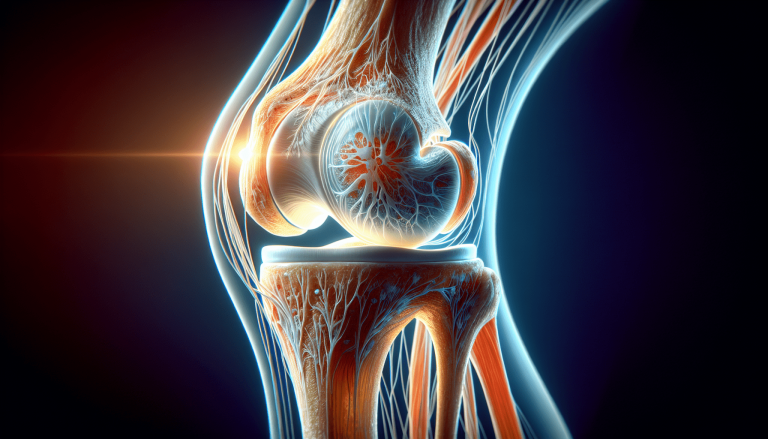Is Turmeric Or Glucosamine Better For Joints?
Have you ever wondered if turmeric or glucosamine is better for your joints? You’re not alone! Many people search for effective ways to relieve joint pain, improve mobility, and maintain joint health. Both turmeric and glucosamine are popular choices, but how do you decide which one might work best for you? We’ll break down the benefits, differences, and potential downsides of each to help you make an informed decision.

Understanding Joint Health
Before choosing between turmeric and glucosamine, it’s important to understand a bit about joint health. Your joints are the connections between your bones; they allow for movement and provide support. When your joints are unhealthy, you can experience discomfort, stiffness, and limited mobility, which can significantly affect your quality of life.
Joint issues can be caused by various factors, including aging, repetitive movements, injuries, and inflammatory conditions like arthritis. Keeping your joints healthy is crucial for maintaining an active and pain-free lifestyle.
What is Turmeric?
A Brief Overview
Turmeric is a bright yellow spice commonly used in Indian cuisine. It comes from the root of Curcuma longa, a plant in the ginger family. Turmeric has been used for centuries in traditional medicine, especially in Ayurvedic and Chinese practices.
The Active Ingredient: Curcumin
The primary active ingredient in turmeric is curcumin. Curcumin is known for its anti-inflammatory and antioxidant properties, which have been the subject of extensive research. These properties make turmeric a popular choice for managing joint pain and inflammation.
Benefits of Turmeric for Joints
Anti-Inflammatory Effects
Curcumin can help reduce inflammation, which is a common cause of joint pain. Inflammation usually occurs when your immune system responds to an injury or infection, but chronic inflammation can lead to ongoing pain and tissue damage.
Antioxidant Properties
Curcumin also acts as an antioxidant, neutralizing free radicals that can damage cells and tissue. This can potentially slow down the degeneration of joints over time.
Pain Relief
Some studies suggest that turmeric can help reduce joint pain in conditions like osteoarthritis and rheumatoid arthritis. People often report feeling less pain and increased mobility after incorporating turmeric supplements into their routine.
| Benefits | Effectiveness |
|---|---|
| Anti-Inflammatory | High |
| Antioxidant | Medium to High |
| Pain Relief | Medium |
What is Glucosamine?
A Brief Overview
Glucosamine is a naturally occurring compound found in your body’s cartilage. It is often taken as a dietary supplement to support joint health and is available in various forms, including glucosamine sulfate, glucosamine hydrochloride, and N-acetyl-glucosamine.
Types of Glucosamine
Glucosamine Sulfate
This is the most researched form of glucosamine and is believed to be the most effective for joint health. It is often combined with sulfate, which may aid in cartilage formation and repair.
Glucosamine Hydrochloride
Although less researched, this form is still popular. It is generally considered less effective than glucosamine sulfate for joint health.
N-Acetyl-Glucosamine
This form is less commonly used and not as well-studied for joint health.
Benefits of Glucosamine for Joints
Supports Cartilage Health
Glucosamine helps maintain the cartilage that cushions your joints. This is crucial for people with osteoarthritis, where cartilage breakdown leads to pain and stiffness.
Reduces Joint Pain
Several studies suggest that glucosamine can help reduce joint pain and improve function, particularly in people with osteoarthritis.
Slows Down Joint Degradation
Regular use of glucosamine may slow down the degradation of cartilage, helping to preserve joint health over time.
| Benefits | Effectiveness |
|---|---|
| Cartilage Health | High |
| Pain Relief | High |
| Slows Degradation | Medium to High |
Comparing Turmeric and Glucosamine
Now that you know the basics of turmeric and glucosamine, how do they stack up against each other for joint health?
Mechanism of Action
Turmeric
Turmeric works primarily through its anti-inflammatory and antioxidant properties. By reducing inflammation, it helps alleviate joint pain. Its antioxidant properties also help protect joint tissues from damage caused by oxidative stress.
Glucosamine
Glucosamine, on the other hand, focuses on maintaining and repairing cartilage. It plays a crucial role in the biosynthesis of glycosaminoglycans, which are essential components of cartilage.
Effectiveness
Turmeric
Turmeric can be highly effective for reducing inflammation and providing pain relief. However, it may not contribute significantly to the structural repair of joints.
Glucosamine
Glucosamine is highly effective for supporting cartilage health and can also help with pain relief. It is particularly beneficial for people with osteoarthritis.
Onset of Action
The onset of action can vary depending on the supplement.
| Property | Turmeric | Glucosamine |
|---|---|---|
| Mechanism of Action | Anti-inflammatory, Antioxidant | Cartilage maintenance, Repair |
| Effectiveness (Pain Relief) | Medium | High |
| Effectiveness (Structural) | Low | High |
| Onset of Action | Faster (within weeks) | Slower (within months) |
Potential Side Effects
Both turmeric and glucosamine can have side effects, but they are generally considered safe when used appropriately.
Turmeric Side Effects
- Gastrointestinal Issues: Some people may experience stomach upset, nausea, or diarrhea.
- Allergic Reactions: Though rare, some individuals may be allergic to turmeric.
- Blood Thinning: High doses of turmeric can act as a blood thinner, which may interact with other medications.
Glucosamine Side Effects
- Gastrointestinal Issues: Some people may experience bloating, gas, or diarrhea.
- Allergic Reactions: Those allergic to shellfish should be cautious, as many glucosamine supplements are derived from shellfish.
- Blood Sugar Levels: Glucosamine can affect blood sugar levels, which is important for people with diabetes.
Best Practices for Taking Supplements
Dosage
It’s crucial to follow the recommended dosages for both turmeric and glucosamine to minimize the risk of side effects.
Turmeric
The typical dose ranges from 500 to 2,000 mg of curcumin per day, divided into smaller doses. It’s often recommended to take turmeric with black pepper (piperine) to enhance absorption.
Glucosamine
The general recommended dose for glucosamine sulfate is 1,500 mg per day, which can be taken as a single dose or divided into smaller doses throughout the day.
Combining Them
You might wonder if it’s possible to take both turmeric and glucosamine. The answer is yes! Many people find that combining these supplements provides comprehensive support for joint health. However, it’s always wise to consult your healthcare provider before starting any new supplement regimen.

Lifestyle Changes for Joint Health
Supplements can be incredibly helpful, but they work best when combined with lifestyle changes that support joint health.
Diet
Eating a balanced diet rich in anti-inflammatory foods can help reduce joint pain and inflammation. Include plenty of fruits, vegetables, whole grains, lean proteins, and healthy fats in your diet.
Exercise
Regular exercise strengthens the muscles around your joints, reducing the strain on them. Low-impact activities like swimming, walking, and cycling are excellent choices for joint health.
Weight Management
Maintaining a healthy weight reduces the pressure on your joints, particularly your knees and hips. If you are overweight, losing even a few pounds can make a significant difference in joint pain and function.
Who Should Consider Turmeric?
You might consider turmeric if you are dealing with inflammation-related joint pain. It’s particularly useful for conditions like rheumatoid arthritis or general inflammatory issues. Its relatively fast onset of action makes it a good choice for those who are looking for quicker relief.
Special Considerations
- Dietary Preferences: Turmeric is a great option for vegetarians and vegans.
- Medication Interactions: If you’re on blood thinners, consult your doctor before taking turmeric.
- Digestive System Sensitivity: Those with a sensitive digestive system should start with a low dose to see how they react.
Who Should Consider Glucosamine?
Glucosamine is particularly beneficial for people with osteoarthritis or those interested in long-term joint maintenance and repair. While it may take longer to see results, its benefits can be significant over time.
Special Considerations
- Shellfish Allergy: If you’re allergic to shellfish, look for glucosamine derived from other sources.
- Blood Sugar Levels: People with diabetes should monitor their blood sugar levels closely.
- Long-term Use: Glucosamine is typically safe for long-term use, making it a good option for chronic joint issues.
What Science Says
Clinical Studies on Turmeric
Numerous studies have investigated turmeric’s effectiveness for joint health. Many of these studies focus on its anti-inflammatory properties. For instance, research indicates that curcumin can reduce symptoms of osteoarthritis and rheumatoid arthritis.
Clinical Studies on Glucosamine
Glucosamine has also been extensively studied, particularly for its effects on osteoarthritis. Several clinical trials have found that glucosamine can reduce pain, improve joint function, and possibly slow the progression of osteoarthritis.
Comparative Studies
There are fewer studies directly comparing turmeric and glucosamine. However, one study found that a combination of the two was more effective at reducing joint pain and improving function than either supplement alone.
Making the Decision
Ultimately, the choice between turmeric and glucosamine may come down to your specific needs and conditions.
If You Prioritize:
- Quick Pain Relief: Turmeric may be the better option.
- Structural Support and Long-term Health: Glucosamine could be more beneficial.
- Comprehensive Support: Considering a combination of both might offer the best results.
Consult Your Healthcare Provider
Before starting any supplement, it’s essential to consult with your healthcare provider. They can help you determine which supplement is appropriate for your condition and ensure that it won’t interact with any medications you may be taking.
Final Thoughts
Choosing between turmeric and glucosamine for joint health is not a one-size-fits-all decision. Both supplements offer unique benefits and potential drawbacks. Turmeric is excellent for reducing inflammation and providing quick pain relief, while glucosamine excels in maintaining and repairing cartilage over the long term. Depending on your specific needs, you might find that one works better for you, or you may benefit from a combination of the two.
Understanding the benefits, mechanisms, and potential side effects of each can help you make an informed decision that aligns with your goals for joint health. Always remember to consult your healthcare provider before starting any new supplement regimen. Your joints will thank you!
Additional Resources
Eliminate pain from your life with 1 natural ingredient
This can literally end the painkillers industry in a flash!
And all it does is use this one ancient Asian plant…
When he found out he was on Big Pharma’s giant payroll, one brave American decided that he’s had enough of his doctor’s lies… And wanted to pursue a safer, 100% natural and efficient way to restore his joint health and mobility without the dangers posed by the painkillers or the life threatening surgeries…
Nobody believed in him, not even his own family…
Until he proved them wrong with a simple, yet astoundingly efficient formula that helped him restore his body to its prime! But while doing that, he uncovered a deep, dark secret Big Pharma wanted hidden for the rest of their days…
Look, see it for yourself and spread the word about it!
>> what Big Pharma doesn’t want you to know about your joints







